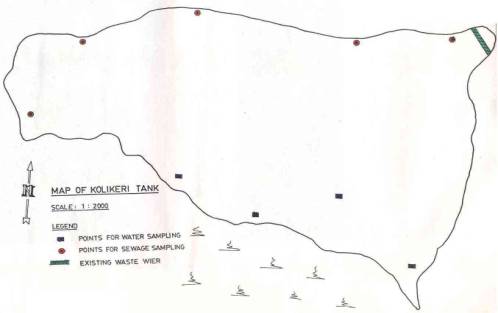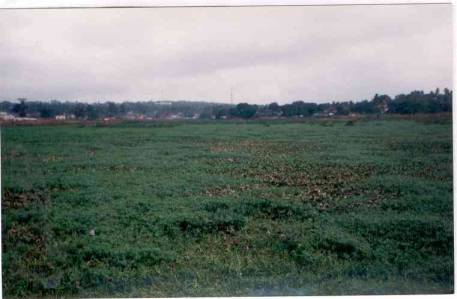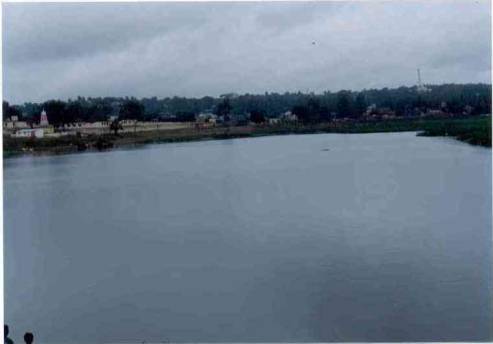
| Previous Session | Paper 1 | Paper 2 | Paper 3 | Paper 4 | Paper 5 | Paper 6 | Paper 7 | Paper 8 | Paper 9 | Paper 10 | Next Session |
SESSION-8: Restoration Methodologies and Conservation Strategies
PAPER-1: Restoration of Kolikere Tank, Dharwad, Karnataka State
Shirkol I.T. and Joshi S.G.
CONTENTS-
Abstract
Introduction
History of Tank
Purpose of Study
Goals and Objectives
Methodology
Area and Map
Proposed Work
Providing Storm Water Treatment Facility
Work Executed
Conclusions
References
| Abstract | up | previous | next | last |
Dharwad City at one time famous as retired persons paradise was cool and calm and was recognised as educational centre. Dharwad was once bestowed with number of tanks, which served as lungs for the city and also supplied water to the people and animals of city. Rapid urbanisation and increasing population compelled the authorities concerned to convert many of these tanks in to commercial/residential centres, ultimately converting them in to concrete jungles.
There are still some more tanks, waiting either for total denudation or all-round development to bring back their old glory and one such among them is Kolikeri Tank.
The sewage from the southern part of city is disposed off by a network of sewerage system, the out let of which is near the said Kolikeri tank. Since the sewerage is very old and there is lack of maintenance from local Corporation Body, there is breakdown of system and the sewage is getting mixed with water of Kolikeri tank. This has resulted in converting the tank in to a sewage body, over a period of two decades and is completely covered with water hyacinth. It has become a breeding place for mosquitoes leading to health hazards and has rendered the tank unfit for normal usage.
It is proposed to restore and develop the tank and convert it in to a useful water body and a recreational centre . This has necessitated a detailed survey and study regarding its location ,boundaries, the extent of area, present condition regarding pollution level and its utilization for different purposes.
This paper aims at studying the restoration of tank by desilting the organic material deposited and diverting the sewage and allowing only the storm water in to the tank.
| Introduction | up | previous | next | last |
Dharwad is a district in Karnataka State, India. Even though Dharwad city is a district head quarter, Hubli situated at a distance of 20 kms. from Dharwad has grown to be the second largest city in Karnataka after the capital city Bangalore. Now the twin cities of Hubli - Dharwad have been merged under one corporation termed Hubli - Dharwad Municipal Corporation (HDMC). The HDMC has a population of 7.25 lakhs as per 1991 census and a projected population of 10 lakhs for the year 2001.
Dharwad city, famous as “retired persons' paradise” was cool and calm and was recognised as an educational centre. Rapid urbanisation and limited natural resources available in Hubli city has shifted the industrial activities from Hubli to Dharwad in the present decade and the impacts of urbanisation are being felt in Dharwad too.
Dharwad , once was bestowed with many tanks viz. Kempagere tank, Yemmikere tank, Sadankere tank, Koppadakere tank, Kolikere tank, Laxmisinganakere tank etc. These tanks were not only serving as lungs for the town but also supplying water to the people and cattle of the town.
The rapid urbanisation and increasing population by leaps and bounds has compelled the authorities concerned to convert many of these tanks either to commercial or residential centres, ultimately converting them into concrete jungles. Now the people use almost all the tanks in one or the other way. There are still some more tanks left waiting either for total denudation or all-round development to bring back their old glory and one such among them is Kolikere Tank.
The sewage of southern part of the city was earlier being disposed off by a network of sewerage system, the outlet of which is near the said Kolikere tank. Since the sewerage system is very old and there is lack of maintenance from HDMC, there is breakdown of the system at many places and the sewage is getting mixed with water of the Kolikere tank. This has resulted in converting the Kolikere water tank in to a sewage tank over a period of two decades and is completely covered with weather hyacinth. It has become a breeding place for mosquitoes leading to health hazards and rendered the tank unfit for normal usage. Waste water entering the Kolikere tank, situated at Hosayellapur in Dharwad city includes the waste from domestic, commercial source, institutional and municipal sources and industries. Disposal of these wastes, which is the responsibility of the Muncipal Corporation, has to be done at the earliest, from health point of view even though it involves heavy cost.
| History of Tank | up | previous | next | last |
Kolikere was originally under the management of the then Muncipal Corporation of Dharwad till 1943. But was taken back by Deputy Commissioner of Dharwad . The surrounding people used this tank for their daily needs, since water supply by taps was not systematic and this increased the pressure on this tank.
Decades ago, when Kolikere was fed by the monsoon rain its ecological communities with producer - plants, consumer- animals, decomposing bacteria and detritus feeders were well balanced. Many water birds species were seen congregating the wetland. As the population increased, the Dhobi's started using the tank for washing clothes and today the wetland is named as Dhobi Ghat. The habitat has been so misused that it needs a thorough cleaning.
Water dependent crops like the paddy, grass and bushes support the nocturnal frogs, fishes, different kinds of birds, etc.
The gazetteer of Dharwad mentions five big tanks for supply of water. One of them is Kolikere called as Bagh - Talab attracted tigers for drinking water. Even today the older generation recall their memories of wild boars and panthers along with other various migrating birds.
The tank, which has such a glorious history has become a ground for breeding mosquitoes. The under ground drainage and gutter water of the town are left into the tank without appropriate treatment. The town garbage is strewn in the surrounding area and the tank bed. The tank bed is silted giving rise to growth of grass and other weeds. Detergents from two Dhobi-Ghats on either side of a tank also contribute to the water, which kills the living organisms. The cattle numbering about 5000 graze the pastures on either side of the tank beds and drink the tank water and in turn people drink the milk of these animals. There are about 800 to 1000 open wells and 100 to 120 bore-wells within the radius of about half kilometres around the tank. This water is being used for house hold purpose and for irrigation. These wells are recharged by the Kolikere tank. . The tank irrigates about 40 acres of land and if a systematic irrigation is done the irrigated land may go up to 300 acres.
The entire area has filthy smell, and mosquitoes generated from these areas affect the general health of the people causing diseases. The life of these people is very pathetic..
The tank discharges about 35,000litres per hour during summer and 1,00,000 liters per hour during peak rainy season. This discharge will flow to Govankoppa joining the Bennehalla on the downward side.
| Purpose of Study | up | previous | next | last |
It is proposed to restore and develop the Kolikere tank and convert it in to a recreational centre. This has necessitated a detailed survey and study regarding its location, boundaries, extent of area, present condition regarding pollution level and its utilisation for different purposes.
This paper aims at studying the restoration of tank by disilting the organic material deposited and diverting the sewage and allowing only the storm water in to the tank.
| Goals and Objectives | up | previous | next | last |
• Achieving a desirable physical, chemical and biological status of the tank water to meet the recreational water quality.
• Restoration of water table.
• Maintaining clean water and improving water habitat.
• Improving aesthetic value of tank.
• Improving the sanitation and health standards.
• Improving the tank shore line through vegetative means.
• Preservation of water for eco-system protection and conservation of water.
| Methodology | up | previous | next | last |
Restoration of the tank is possible only when its boundaries are demarcated and separated from mixing with the sewage flow. The sewage flow has to be diverted from the tank area by construction of bunds and sewages channels. First, this will avoid the suspended solids being deposited in to the tank and secondly, the tank can be desilted for the existing organic matter so as to restore the tank
| Area and Map | up | previous | next | last |
The area of Kolikere tank is about 35 acres and the deposition of the organic matter varies from 1 m. deep at few places to 4 m. deep at many places of the tank. Complete desiltation of the tank for restoration will incur expenditure in crores, which may be beyond the financial capabilities of the local authorities to take up this work. Plate No.1 shows the details of boundary conditions, water sampling points, land slope etc. of the tank.

Plate No.1

Plate No.2 Photograph of the tank before restoration.
EXISTNG WATER QUALITY
Sl.No. |
Test |
Results |
01 |
B.O.D 3 @ 27 ° C |
154mg/litre |
02 |
C.O.D. |
220mg/litre |
03 |
Chlorides |
150mg/litre |
04 |
Sulphates |
15.36mg/litre |
05 |
Total dissolved salts |
690mg/litre |
06 |
Kjeldalh's nitrogen |
16.8mg/litre |
[B.O.D. – Bio Chemical Oxygen Demand
C.O.D. – Chemical Oxygen Demand]
DISCHARGE IN HIREKERE TANK
0.00846 m 3 / sec
730.95m 3 / day
i.e. 730 x 10 x 10 x 10 = 7,30,000 litres / day
i.e. 30417 litres / hour
say 30,500 litres / hour
say between 30,000 to 40,000 litres / hour
| Proposed Work | up | previous | next | last |
1. RE-LAYING OF SEWER LINES
The sewer lines in the catchment are very old and presently the system is not in a position to take the full load and thus many manholes are overflowing into the drains. Adding to this problem some of the people who have constructed the houses authorised or unauthorised have connected the sewage directly into the storm water drains. This sewage needs to be diverted into the sewer lines. This activity is very important in order to envisage the permanent remedy to improve the tank water quality.
| Providing Storm Water Treatment Facility | up | previous | next | last |
2. DIVERSION CHANNELS
Since the storm water drains bring a lot of sewage round the year in addition to water with high organic content during the onset of monsoons it is necessary to divert this flow and hence a diversion channel needs to be established. At the entry point a gate should be provided for diverting the initial storm water.
3. DREDGING AND DESILTING (WATER HYACINTH)
Dredging and de-silting are the most common methods of tank restoration. Increasing the depth of the lake reduces the littoral zone and provides a substantial increase in the tank water volume. Removal of highly organic sediments can reduce oxygen demand. Studies were conducted to evaluate alternative de-silting/dredging, both for tank deepening and sediment treatment. Dewatering and sediment digestion using aeration, hydrogen peroxide, ozone and nitrate are the alternative methods for sediment consolidation. The tanks most susceptible to in situ treatment are the tanks having high organic sediments. Hirekere tank is most suited for this method as this tank is filled with a lot of organic debris. Even after consolidating the sediments using either aeration or hydrogen peroxide, it is required to remove these sediments by de-silting.
Sediment consolidation by de-watering and aeration considerably reduce the sediment volume. After de-watering and consolidation of the organic sediments the tank bed may be allowed for drying. After drying up, the sediments along with the silt can be removed by earth moving equipments. The de-silted earth can be effectively used for creating the shore line and also walking paths around the tank.
For determining the quantity of silt to be removed in the tank it is necessary to conduct a detailed topographic survey of the tank at 50 m grid interval. Although estimation indicates, about 4-5 lakhs cu. m .
4 SHORE LINE VEGETATION
Under undisturbed conditions shoreline builds up its own stratified vegetation and continuously interacts with the tank water. The stratified vegetation consists of trees, shrubs, grasses, sub-merged vegetation, sub-merged anchored vegetation and floating aquatic vegetation. This type of system needs to be re-created around the tank in order to rebuild the life system of the tank waters. The vegetation not only helps in absorbing the nutrients from the tank water but also provides food for the fauna. The type of tree species and shrubs will be decided depending on the need and suitability during the detailed planning.
5 RECREATIONAL FACILITIES
Since the tank is situated in the strategic point, it necessary to develop recreation facilities like children corner, water sports complex, library, walking paths, jogging tracks and other facilities.
Pre- conditional requirement from the concerned organisations.
• Clearance from the Revenue Department as the tank is under their custody.
• Assurance from the Urban Water Supply and Drainage Board and the Hubli-Dharwad Municipal Corporation for modernising the sewers in the catchment area.
• Assurance from the Slum Clearance Board to take up the works in the slums situated in the Hirekere tank catchment area.
• Assurance from the Pollution Control Board to spare the technical services when required.
| Work Executed | up | previous | next | last |
The project proposal was given to HDMC for further action in the matter during 1998-99. Incidentally the restoration of the tank was undertaken by the Minor Irrigation Department ,Dharwad during 1999 from May to December by dredging and desilting the tank at a total cost of Rs.45 lakhs.
The overall operation included
There is one more proposal now for desilting the tank to an extent of 1,82,000 cu.m at a cost of Rs. 27.5 lakhs
From these operations it is hoped that the tank will be free from organic debris deposited since decades. The changed environment of the tank after the first face of desilting has been shown in Plate .3
The next phase of operation would be to convert it in to a recreational centre with all modifications suggested.

Plate No.3 Photograph of the tank after first phase of restoration.
| Conclusions | up | previous | next | last |
| References | up | previous | next | last |
• I.T.Shirkol Water Hyacinth: An unconventional source of energy , case study Kolikeri tank Dharwad, Karnataka State , Masters Thesis !997
• R .K. Shankar Class I Contractor Instran Structural engineering Company(Personal Communication)
| Address: | up | previous |
Civil Engineering Department,
SDMCET, Dharwad 580 002.
Karnataka, India.
Phone: 448327.
E-mail: itshirkol@rediffmail.com
sadanandgjoshi@yahoo.com